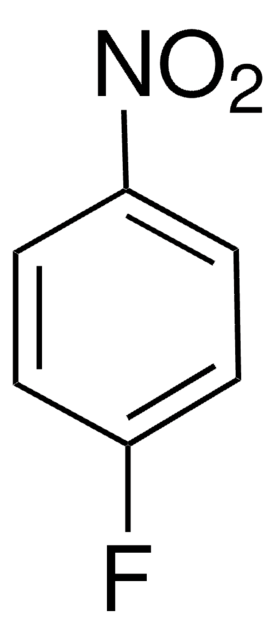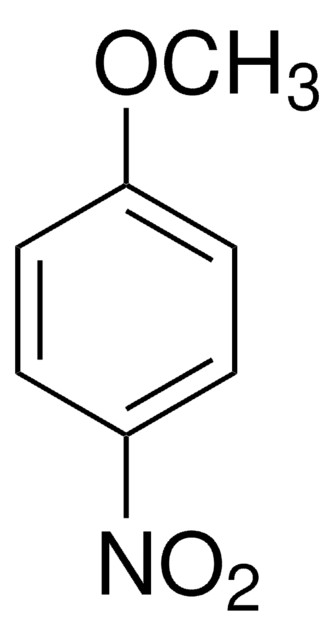C59122
1-Chloro-4-nitrobenzene
99%
동의어(들):
1-Nitro-4-chlorobenzene, 4-Chloro-1-nitrobenzene, 4-Chloronitrobenzene, 4-Nitro-1-chlorobenzene, PNCB, p-Nitrochlorobenzene, p-Nitrophenyl chloride
로그인조직 및 계약 가격 보기
모든 사진(1)
About This Item
Linear Formula:
ClC6H4NO2
CAS Number:
Molecular Weight:
157.55
Beilstein:
508691
EC Number:
MDL number:
UNSPSC 코드:
12352100
PubChem Substance ID:
NACRES:
NA.22
추천 제품
vapor density
5.4 (vs air)
Quality Level
vapor pressure
0.09 mmHg ( 25 °C)
분석
99%
양식
crystals
autoignition temp.
500 °F
bp
242 °C (lit.)
mp
80-83 °C (lit.)
density
1.298 g/mL at 25 °C (lit.)
SMILES string
[O-][N+](=O)c1ccc(Cl)cc1
InChI
1S/C6H4ClNO2/c7-5-1-3-6(4-2-5)8(9)10/h1-4H
InChI key
CZGCEKJOLUNIFY-UHFFFAOYSA-N
유사한 제품을 찾으십니까? 방문 제품 비교 안내
관련 카테고리
신호어
Danger
유해 및 위험 성명서
Hazard Classifications
Acute Tox. 3 Dermal - Acute Tox. 3 Inhalation - Acute Tox. 3 Oral - Aquatic Chronic 2 - Carc. 2 - Muta. 2 - STOT RE 2
Storage Class Code
6.1A - Combustible acute toxic Cat. 1 and 2 / very toxic hazardous materials
WGK
WGK 3
Flash Point (°F)
255.2 °F - closed cup
Flash Point (°C)
124 °C - closed cup
이미 열람한 고객
Qiang Chen et al.
Chemistry, an Asian journal (2018-05-01)
Platinum nanoparticles encapsulated into zeolite Y (Pt@Y catalyst) exhibit excellent catalytic selectivity in the hydrogenation of substituted nitroarenes to form the corresponding aromatic amines, even after complete conversion. With the hydrogenation of p-chloronitrobenzene as a model, the role of zeolite encapsulation
Ruiyang Qu et al.
Nanomaterials (Basel, Switzerland), 8(9) (2018-09-08)
The solvent-free selective hydrogenation of nitrobenzene was carried out using a supported AuPd nanoparticles catalyst, prepared by the modified impregnation method (MIm), as efficient catalyst >99% yield of aniline (AN) was obtained after 15 h at 90 °C, 3 bar
Yun Zhang et al.
Biodegradation, 20(1), 55-66 (2008-05-30)
Comamonas sp. strain CNB-1 can utilize 4-chloronitrobenzene (4CNB) as sole carbon and nitrogen source for growth. Previous studies were focused on 4CNB degradative pathway and have showed that CNB-1 contained a plasmid pCNB1 harboring the genes (cnbABCaCbDEFGH, cnbZ) for the
Liang Zhu et al.
Water research, 46(19), 6291-6299 (2012-10-17)
Using a combined zero-valent iron (ZVI) and anaerobic sludge system as the platform, the hydrogen utilization and reductive mechanism of p-chloronitrobenzene (p-ClNB) were investigated in the study. Results showed that the corrosion of ZVI could be used as a source
Miaomiao Ye et al.
Journal of hazardous materials, 184(1-3), 612-619 (2010-09-22)
TiO(2) hollow microspheres were synthesized by a simple hydrothermal method followed by calcination at different temperatures ranging from 400 to 800°C. The prepared samples were characterized by XRD, SEM, TEM, SAED, HRTEM, N(2) adsorption, and UV-vis spectroscopy. The photocatalytic activities
자사의 과학자팀은 생명 과학, 재료 과학, 화학 합성, 크로마토그래피, 분석 및 기타 많은 영역을 포함한 모든 과학 분야에 경험이 있습니다..
고객지원팀으로 연락바랍니다.













